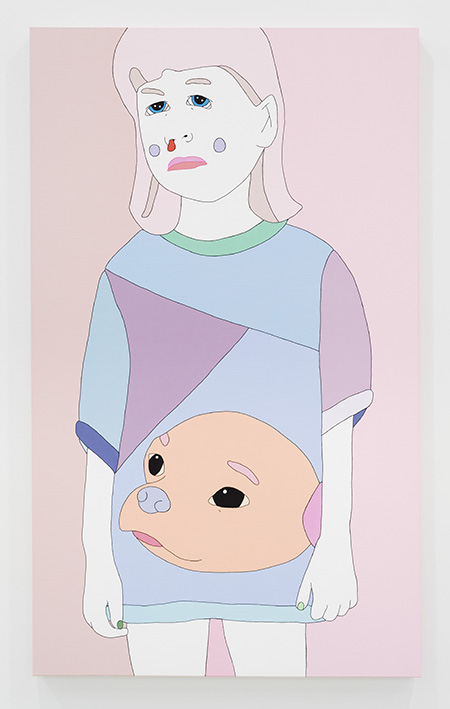Lonely Girl

If 2007 saw the resurgence of feminist art via the exhibition ‘WACK! Art and the Feminist Revolution’, it seems already like a moment disanalogous with our own. How is it that, 41 years after the artist-run space Womanhouse and two decades after the dawn of Riot Grrrl, that a male curator was able to publish a press release leading with this line: ‘Martos Gallery is pleased to present Lonely Girl, a group show consisting of seven female artists, all under the age the age of 30’? Is the inclusion of young female artists in contemporary art exhibitions still so rare that their gender and age should be the first, and implicitly most important, fact about a show? Or did the curator – writer and artist Asher Penn – simply throw his arms up admitting his exhibition’s implicit fetishism? Even more fraught was Martos Gallery’s full-page advert in the September issue of Artforum featuring not a photograph of an art work in the show, but the faces of all the artists involved.
The show featured Al Baio, Petra Cortright, Maggie Lee, Greem Jellyfish, Bunny Rogers, Analisa Teachworth and Amalia Ulman – artists who are well-known online, often working in both Internet-based as well as physical mediums. Cortright, for one, has carved a place in new media art history for her video VVEBCAM (2007), which features the artist doing what we all did best at the height of Web 2.0: staring at ourselves on the screen, screwing around with buttons and cam effects. Penn writes, ‘Self-portraiture (aka “the selfie”) is so much a part of both [the artists’] art works as well as the documentation of their lives, that it is often difficult to distinguish which one is which.’ Right on. Penn duly points out that the performance of self online can be so produced and even parodying that it could be considered a creative practice in itself, though the art world has yet to develop the frameworks through which to understand such endeavours. And while the selfie is not a gender-specific phenomenon as the exhibition’s all-female line-up suggests (cf. the work of Brian Droitcour, Steve Roggenbuck, Michael Manning), young female self-portraiture is often platitudinized as dangerous territory in which feminine vanity will overtake a project’s conceptual merit.
So it was unfortunate that ‘Lonely Girl’ ignored such fertile ground, containing far fewer screens, selfies or web-based work than one would anticipate from an all-faces-no-art ad. As a whole, the installation bore a rag-tag quality one might expect from emerging artists unaccustomed to showing in Chelsea galleries, but the slight, low-production-value work also bears a sensibility that consciously reacts to and confronts preconceptions of femininity, often subjugating its tropes. We saw paint sloppily applied onto unprimed cotton, abounding pastel colours, sticker collections, glittery ribbon. In the front space, Greem Jellyfish arranged artefacts on and around a display case related to the made-up, hyperbolically Asian character Hannah Choi. Pinned to a curtain surrounding the display case was a printed-out screenshot noting, assumedly, Choi’s female inspirations: ‘ISADORA DUNCUN, YAYOI KUSAMA, NIKKI S LEE, ONO YOKO, CINDY SHERMAN, TRACY EMIN, MARINA ABROMOVIC’ – these purposeful misspellings suggesting an Internet-age faux-naiveté.
Videos by Maggie Lee and Analisa Teachworth provided the exhibition with much-needed complexity. Lee’s nine short-but-sweet videos installed on a sticker-covered vintage TV/VCR combo track the artist combatting the banality of the everyday by creating a game out of walking, stomping on things left on the street, liaising with a Garfield doll, or following a woman around a mosh pit (TV87, 2013). Teachworth’s video Don’t Ask, Don’t Tell (2013) finds two androgynous lovers with bags over their heads spooning, despondently reciting lines peppered with ennui. Most compelling and elegiac was a wet mop, dyed purple and donning a large bow, installed in a corner and titled Self Portrait (mourning mop) (2013) by Bunny Rogers. Amalia Ulman’s series of diminutive wire sculptures of flowers and children meet, perhaps too eagerly, implicit critiques of slightness and fragility (27 Roses, 9 Butterflies and 6 Girls, all 2013). Cortright’s only work here was Night Heat 8 (2011), a digital painting on satin, sadly omitting the webcam work for which she is best known and which the exhibition desperately needed.
While it seems implicit that one of Penn’s objectives was to circumvent the feminist dogma that an older man – who is, notably, over 30 – can’t curate a group of younger, female artists, he floundered by both failing to portray the power in online self-representation as a viable artistic practice located in the gallery and by blithely ignoring the politics of the male gaze and predation endemic to such a slippery curatorial endeavour. We need greater representation of young women in contemporary exhibitions, but not at the expense of showcasing the artist, her personality or looks over her work. This insidious debutante ball exhibition model suggests, via its all-female fetishism, that these artists should be relegated to consider female, rather than universal, issues – an indefensible position in 2013.
















